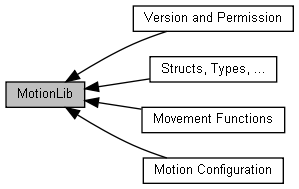
|
Modules | |
| Motion Configuration | |
| Movement Functions | |
| Version and Permission | |
| Structs, Types, ... | |
This motion library provides functionality for defining an axis, commanding motion and getting axis information.
AxisData of the regarding axes. This variable is part of the GVL "GVL_Base" of the library "BASELIB".AxisData, type "ML_AXIS_DATA_SM" please consult the IndraWorks help.The conceptual difference between a drive or device and an axis is that a drive or device is the physical device that is connected to the sercos bus and can be configured via S and P parameters. An axis is assigned to a drive or device and is accessible through A parameters. Multiple axes can be assigned to a drive or device (for example, one axis is a real axis that is moving the drive, a second axis is connected to the same drive, but implements an encoder axis).
The following functions all deal with the motion of an axis. In general, "axis" is used to address an axis. The motion commands can be divided roughly in single axis commands, where a single axis is moved, synchronous commands, where axes are moved in relation to master and utility functions like power or homing of an axis. Each motion command usually uses a structure to pass on the information about a particular move. The command will be executed in the control and returns a handle. This handle must be used in future requests for getting status information. The handle and the axis reference a particular motion command. One axis can have multiple active commands (for example, power is one and a move is commanded). On the contrary, a currently executed move will be interrupted as soon as a new move is commanded.